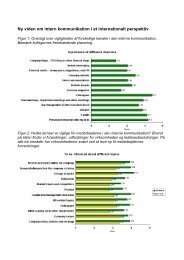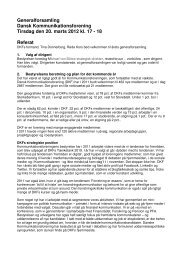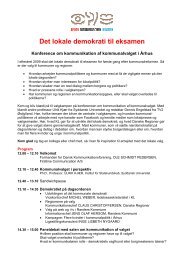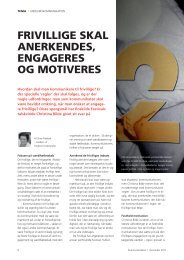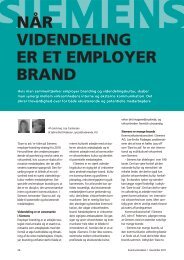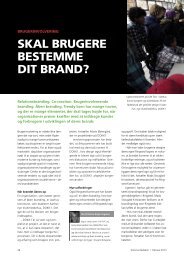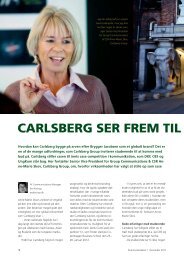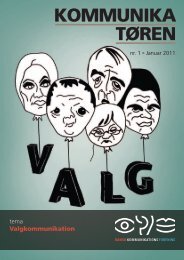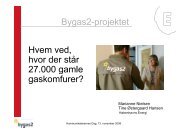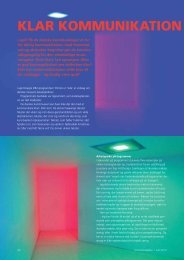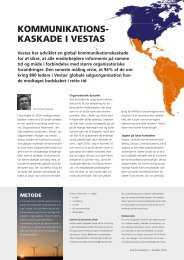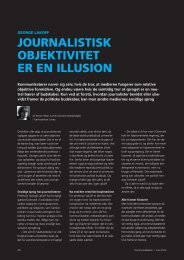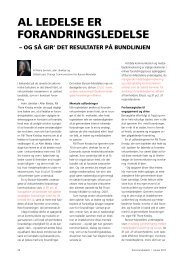Table of contents
Table of contents
Table of contents
Create successful ePaper yourself
Turn your PDF publications into a flip-book with our unique Google optimized e-Paper software.
<strong>Table</strong> <strong>of</strong> <strong>contents</strong><br />
1.1 Rules and regulations 1<br />
1.2 Scope and hand-in formats 1<br />
1.3 Evaluation criteria 1<br />
2 3 September 2011, Carlsberg Group Headquarters, Valby 2<br />
3 Carlsberg’s History and Heritage 4<br />
4 Boulder: The re-launch <strong>of</strong> Carlsberg Group’s flagship brand 5<br />
5 Carlsberg Group’s Stand 7<br />
6 Carlsberg Group’s Winning Behaviours put into action 9<br />
7 The Strategy Wheel 10<br />
8 Local idea with global scope - the beer list 11<br />
9 The GloCal approach 12<br />
10 The scrutiny <strong>of</strong> beer: Dark markets 13<br />
11 Thirst for Beer 14<br />
12 Carlsberg Group’s consumer segments: The right occasion and the right brand 16<br />
13 Carlsberg Group: One <strong>of</strong> the world’s largest FMCG companies 18<br />
14 Summing up 19<br />
15 Perspectives on the case – Communication challenges 20<br />
The Corporate Brand Perspective 20<br />
The Financial Perspective 20<br />
The Intercultural Perspective 20<br />
The CSR Perspective 21<br />
16 Instructions 22<br />
17 Overview <strong>of</strong> handed-out material 23<br />
Carlberg Breweries A/S (Director <strong>of</strong> Corporate Communications Iben Johannesen and Communications Coordinator<br />
Maria Tejada Ljungbeck) prepared this case for ComCaseCompetition 2012 with assistance from Copenhagen<br />
Business School (Associate Pr<strong>of</strong>essor Karl-Heinz Pogner, Department <strong>of</strong> Intercultural Communication<br />
and Management).
1.1 Rules and regulations<br />
The competition stretches from Wednesday January 25th to Wednesday January 26th.<br />
The participants have to hand in no more than 7 Power Point- slides, and an executive summary <strong>of</strong> no more<br />
than 2500 Standard Typographic Units (STU) by 12.30 n January 26th.<br />
1.2 Scope and hand in formats<br />
The participants (groups <strong>of</strong> 4- 5 students) should prepare a problem-based and solution-oriented presentation<br />
(7 slides) and a short executive summary (2500 STU) <strong>of</strong> their findings and recommendations about their<br />
chosen research question and their chosen perspective/s concerning the case.<br />
The 3 best presentation drafts and executive summaries will go to the final, where the finalists present their<br />
findings and recommendations in a 15 minutes pitch for the jury, who will ask questions and discuss the solutions<br />
for 10 minutes. The groups decide themselves how to do the presentation.<br />
1.3 Evaluation criteria<br />
The evaluation <strong>of</strong> the groups’ presentations will be based on the following evaluation criteria:<br />
The participants should demonstrate that they are able to<br />
Identify, analyze and solve a key problem<br />
Apply theories, models and key concepts to the practical communication in a solution oriented manner<br />
Design pr<strong>of</strong>essional, innovative and creative – but realistic - communication strategies that are embedded in<br />
the organizational context<br />
Reflect upon how preconditions, chosen key concepts, methods and theories have an impact on strengths,<br />
limitations and weaknesses <strong>of</strong> the problem solution<br />
Communicate the results in an adequate, correct language in a coherent, convincing presentation and discussion<br />
that fulfills rhetorical, academic and pr<strong>of</strong>essional standards.<br />
NOTES
1. 3 September 2011, Carlsberg Group Headquarters, Valby<br />
The elevator doors slowly opened onto the 20th floor exposing dark mahogany floors. Mr. Jørgen Buhl Rasmussen<br />
glanced at the Carlsberg memorabilia hanging impeccably on the walls. It was late. The sun had given<br />
way to the moon hours ago, and there were probably still a few Carlsberg employees and their families milling<br />
around the Carlsberg district, sipping on beers and listening to the last verses <strong>of</strong> D.A.D. It would have been<br />
hard to be in Copenhagen today without noticing that Carlsberg was celebrating its founder, J.C. Jacobsen’s<br />
200th birthday.<br />
Mr. Buhl Rasmussen thought back to the speech he made in TAP1, the overwhelming cheer and positive energy<br />
his Danish and international employees exhibited had awed him. He made his way to the window. Standing<br />
high above the rest <strong>of</strong> Copenhagen, CEO <strong>of</strong> the Carlsberg Group, the 4th largest brewery in the world, with<br />
over 40,000 employees on three continents, Jørgen Buhl Rasmussen’s thoughts brought him back to today’s<br />
event.<br />
There had been several incentives for creating such a celebration out <strong>of</strong> the 200th anniversary. Foremost it<br />
was to honour J.C. Jacobsen, Carlsberg’s founder. Moreover 3 September was an important part <strong>of</strong> the transformation<br />
journey that the Carlsberg Group as a global brand was on; the celebration was meant to illustrate<br />
how Carlsberg had made a strategic decision to use the company’s heritage to look to the future and ultimately<br />
inspire people today.<br />
Since his promotion from Executive Vice President to President and CEO in 2007 up until quite recently, things<br />
had been looking promising for the Carlsberg Group. Carlsberg’s transformation journey took <strong>of</strong>f long before<br />
Mr. Buhl Rasmussen had joined the corporation. Back in 1999, Carlsberg was primarily a regional brewer in<br />
Scandinavia and the UK. By 2007 the Carlsberg Group saw itself as the market leader in Northern Europe and<br />
parts <strong>of</strong> Eastern Europe and Asia.<br />
In April 2008 the Carlsberg Group made the biggest acquisition ever made in Denmark by acquiring Scottish &<br />
Newcastle. This had proven very beneficial for the company, not only acquiring S&N’s shares <strong>of</strong> French, Greek,<br />
Chinese and Vietnamese operations, the Carlsberg Group had also gained sole ownership <strong>of</strong> Baltika Breweries,<br />
the biggest FMCG (Fast Moving Consumer Goods) company and the biggest brewer in Russia. In 2008 the<br />
media had declared Carlsberg Group as having entered the super league and the venture with Baltika Breweries<br />
had strengthened Carlsberg’s position on the global beer market considerably.<br />
Things continued to look increasingly promising as the newly acquired local markets and brands were integrated<br />
into Carlsberg, creating what was now the Carlsberg Group – 140 markets and 500 brands under one ro<strong>of</strong>.<br />
The Carlsberg Group controlled 43% <strong>of</strong> total volume in Northern and Western Europe, 41% <strong>of</strong> total volume in<br />
Eastern Europe, and 16% in Asia with projections to improve competitiveness and earnings, ensure pr<strong>of</strong>itable<br />
growth, and build growth platforms respectively.<br />
As the Carlsberg Group had grown to include diverse brewers and brands from around the world, Mr. Buhl<br />
Rasmussen and his team became increasingly aware <strong>of</strong> the importance to acknowledge that each <strong>of</strong> these<br />
companies represented its own corporate culture, regional personality and point <strong>of</strong> market differentiation<br />
NOTES
and it was becoming crucial to unify these companies as the Carlsberg Group. Among employees there still<br />
seemed to exist a divide between countries, markets and cultures, and with projections for more growth, as<br />
well as further expansions and acquisitions it was becoming imperative for the Carlsberg Group to communicate<br />
an authentic and inspiring Group story, while still maintaining a “GloCal” (Global and Local) approach,<br />
and retaining regional and local brand value. Carlsberg Group faced the challenge <strong>of</strong> what seemed to be a lack<br />
<strong>of</strong> cultural communication and understanding between the various markets in which the global brewery exists.<br />
This included cultural challenges among old, mature markets and new emerging beer markets, as well as<br />
perhaps a deficiency in clear communication regarding how things are done in different parts <strong>of</strong> the world. Beyond<br />
this many long-established breweries that had been bought up by Carlsberg Group such as Baltika and<br />
Brasseries Kronenbourg possessed traditions and a certain pride that could contest some <strong>of</strong> the procedures<br />
implemented by the Carlsberg Group on a whole. This said, it would be a lot easier said than done to execute<br />
the actual implementation <strong>of</strong> the GloCal approach.<br />
Overlooking the old brewery district in Valby, Jørgen Buhl Rasmussen thought back to the current trouble in<br />
Russia. The Russian beer market was negatively impacted by significant duty increase in 2010 and a challenging<br />
macroeconomic environment, and it had only been a few weeks since the Carlsberg Group’s 2011 Quarter<br />
2 (Q2) results had been released on 17 August. Q2 had not reaped the results that the company had expected;<br />
Eastern Europe came in below expectations, with a disappointing Russian market performance and although<br />
the Northern and Western Europe regions and Asia had shown positive performance with pr<strong>of</strong>it improvements<br />
and market growth, the decline in Russia was continuing to impact the Carlsberg Group negatively. Despite the<br />
improved macroeconomic conditions in Russia, local consumers had not yet adjusted to substantial price increases<br />
and the weather conditions in Q2 had also been unusually poor. Baltika Breweries, Carlsberg’s Russian<br />
conglomerate that stood behind the best selling beer in Europe - Baltika, had simply not been able to match<br />
its own recognized name and Carlsberg Group<br />
Sitting down slowly, Mr. Buhl Rasmussen was once again reminded <strong>of</strong> J.C. Jacobsen’s birthday today. The<br />
sun had beat down on the Carlsberg district. Children and adults alike had enjoyed the warm temperatures<br />
that are unusual to Copenhagen in September. The area buzzed with activity, over 40,000 people had been<br />
expected to show up to celebrate J.C. Jacobsen’s birthday. The celebration had been the perfect example <strong>of</strong><br />
the Carlsberg Group drawing from its history and heritage, and ultimately inspiring employees and consumers<br />
alike.<br />
Mr. Buhl Rasmussen and his team would have to use today as a trampoline; the energy that had been so<br />
clearly reflected in the Carlsberg employees and the spirit that could be felt all around the Carlsberg district<br />
was the exact message the Carlsberg Group needed to relay across all 140 markets.<br />
NOTES
2. Carlsberg’s History and Heritage<br />
Carlsberg’s rich heritage in scientific discoveries dates back to 1845 when a young J.C. Jacobsen (J.C.) made his<br />
way back from Munich to Copenhagen in a horse drawn stagecoach. Gently nestled on his knee lay a hatbox<br />
that contained something that has since revolutionized the brewing industry; a special yeast from a brewery in<br />
Germany. The living yeast survived the journey, and it was not long before J.C. was ready to produce 300 barrels<br />
<strong>of</strong> Bavarian lager beer which quickly proved very popular. Perched on a hill in Valby J.C. Jacobsen founded<br />
his brewery in 1847, calling it Carlsberg in honour <strong>of</strong> his only son Carl and the “mountain” (“bjerg” in Danish) on<br />
which the brewery lay.<br />
J.C. was not one to keep innovations to himself and it did not take long for Carlsberg’s founder to realize the<br />
important connection between natural science and industrial innovation. A man that demanded quality, J.C.<br />
founded the Carlsberg Laboratory in 1875 as an independent institution. Nowadays the Carlsberg Laboratory<br />
still makes outstanding scientific discoveries which continue to benefit and transform the beverage industry. In<br />
1883 Scientist Emil Christian Hansen developed a method for propagating pure yeast, named Saccharomyces<br />
Carlsbergensis. Before that impurities in yeast meant that beer would <strong>of</strong>ten turn sour during production or<br />
transportation.<br />
The clean yeast was given freely to the world, and is still used in every mass-produced lager beer today. J.C.’s<br />
inventions in the art <strong>of</strong> beer production and his disposition for sharing his and his colleagues’ scientific discoveries<br />
with the world have laid the cornerstone <strong>of</strong> the modern brewing industry.<br />
J.C.’s son Carl Jacobsen would go on to be just as talented a brewer as his father. A patron <strong>of</strong> art, Carl<br />
amassed a huge art collection as well as building two museums to house the paintings. One <strong>of</strong> the museums,<br />
the Ny Carlsberg Glyptotek in Copenhagen is still open to the public today. Much like his father, Carl was<br />
also armed with a deep passion and interest in the art <strong>of</strong> beer making. In 1903 Carlsberg and Tuborg’s United<br />
Breweries signed a formal agreement <strong>of</strong> cooperation that was to last 100 years, the “1903-agreement” would<br />
ensure that although the breweries were still to run independently and in competition, it was agreed that they<br />
would share all pr<strong>of</strong>its and losses, and participate equally in each other’s investments in new installations.<br />
In 1882 J.C. Jacobsen carved the ‘golden words’ into the stonework <strong>of</strong> the original Carlsberg brewery in 1882.<br />
The mision and vision <strong>of</strong> those days:<br />
“In working the brewery it should be a constant purpose, regardless <strong>of</strong> immediate gain, to develop the art <strong>of</strong><br />
making beer to the greatest possible degree <strong>of</strong> perfection so that this brewery as well as its products may ever<br />
stand out as a model, and through their example, assist in keeping beer brewing in this country at a high and<br />
honourable level.” J.C. Jacobsen, Carlsberg’s Founder.<br />
NOTES
3. Boulder: The re-launch <strong>of</strong> Carlsberg Group’s flagship brand<br />
5 April 2011. A day 40,000 employees in over 150 countries across the globe had been anticipating for months.<br />
Today the Carlsberg Group was launching a new brand proposition for its flagship beer Carlsberg, rolled out<br />
across all markets simultaneously in what was the company’s largest international makeover to date. This<br />
was no small feat; a global re-launch <strong>of</strong> the iconic Carlsberg brand would not only see the removal <strong>of</strong> the<br />
company’s globally recognized tagline “Probably the best beer in the world” replaced with the new, modernized<br />
proposition, “That calls for a Carlsberg”, but the international transformation would be unveiling a package<br />
that would bring changes to both the brand proposition and Carlsberg’s visual identity.<br />
Standing on the stage <strong>of</strong> Carlsberg’s TAP2, Khalil Younes, Senior Vice President <strong>of</strong> Group Sales, Marketing and<br />
Innovation (GSMI) welcomed Carlsberg’s employees to what was internally referred to as C-Day: “Carlsberg<br />
is a fantastic brand, but the brand has even more potential that can be cultivated. Now, we also want to add<br />
essence to our brand. It is time we take Carlsberg to the next level,” Mr. Younes paused before revealing to<br />
thousands <strong>of</strong> employees Carlsberg’s largest global re-launch in the history <strong>of</strong> the company.<br />
“That calls for a Carlsberg”<br />
Consumers will no longer have to wonder if Carlsberg is probably the best. From now on a new tagline will be<br />
on the tip <strong>of</strong> beer drinkers’ tongues. “That calls for a Carlsberg” is Carlsberg’s modernized tagline, a proposition<br />
that aims to celebrate Carlsberg’s heritage and values, while connecting with today’s generation <strong>of</strong> active beer<br />
drinkers. The new positioning encourages consumers to ‘step up and do the right thing’, subsequently gratifying<br />
themselves with a Carlsberg for their good deeds.<br />
The transformation <strong>of</strong> Carlsberg’s classic tagline falls closely in line with the revolution <strong>of</strong> consumers today.<br />
Consumer behaviour is significantly moulded by information, technology, travel and social media, all available<br />
with the swipe <strong>of</strong> a finger. Young, independent adults today do not wait for things to happen, they go out and<br />
make them happen. They are prepared to take risks, to explore and accept new opportunities and challenges,<br />
while maintaining courage and integrity in the way they lead their lives. They are prepared to step up and do<br />
the right thing.<br />
NOTES
4. Carlsberg Group’s Stand<br />
In 2010 the Carlsberg Group adopted a new global vision that attempts to capture the essence <strong>of</strong> the Group,<br />
the unique identity, personality and diversity <strong>of</strong> the Group across cultures. Opposite to the product brands,<br />
Carlsberg created “The Stand” – something the Group has chosen to use as a definition for what the global<br />
brewer stands for. The Stand, a dictum which unites employees across markets, regions and cultures, is so to<br />
speak an updated version <strong>of</strong> the ‘golden words’ that J.C. Jacobsen had carved into the stonework <strong>of</strong> the original<br />
Carlsberg brewery in 1882, and the motto aims to take the essence <strong>of</strong> the Carlsberg Group’s identity and<br />
render it into 91 words.<br />
The Stand touches upon three topics:<br />
• The always burning passion, thirsting for better<br />
• Strength in unity. We brand as many, but stand as one<br />
• The ambition and courage to raise the bar<br />
According to Michael Kreutzfeldt, Company Branding Manager, the establishment <strong>of</strong> The Stand came from<br />
employees lacking a clear message <strong>of</strong> what unites the Group on a global level. He realized that no matter<br />
which region or department he and his team asked for input from, the same basic traits kept popping up. In<br />
order to express and reflect the people behind the Carlsberg Group, The Stand was formed.<br />
Carlsberg has defined The Stand as a vision that is increasingly relevant to the Carlsberg Group today and<br />
shows that ‘we never settle, but always thirst for better’. Input has been used from various long-established<br />
brands around the world so that every Carlsberg employee, regardless <strong>of</strong> where they come from or where they<br />
work, can recognize a little <strong>of</strong> their company’s past and present in Carlsberg Group’s Stand. Beyond connecting<br />
Carlsberg employees across the globe, The Stand also aims to show what the Carlsberg Group aspires for; a<br />
guide to target setting, making decisions and people development.<br />
“Our stakeholders are increasingly looking at what a company stands for when they make decisions,” explains<br />
Anne-Marie Skov, Senior Vice President, Communications & CSR. “We want an association with Carlsberg<br />
Group to add extra value to the products we sell and the companies we are. The Stand gives us a common<br />
way to express our identity whether we want to influence consumers’ perceptions, convince employees that we<br />
are best place to work for or make new deals with customers and partners.”<br />
NOTES
NOTES
5. Carlsberg Group’s Winning Behaviours put into action<br />
The Stand tells what the Carlsberg Group stand for as a company. As a supplement - you can call it the values<br />
- the Carlsberg Group has the five Winning Behaviours; a set <strong>of</strong> action-oriented principles <strong>of</strong> best behaviours<br />
that provides employees across the Group guidance on how to work with colleagues and customer and drive a<br />
performance culture.<br />
The Winning Behaviours pull the Carlsberg Group as a company together across national borders and functions<br />
as well as promoting commitment and engagement. All companies within the Group have implemented<br />
the Winning Behaviours as guiding principles. The five iconic characters hang in the production hall in<br />
Carlsberg Kazakhstan; Carlsberg Malaysia has rolled out a full package <strong>of</strong> workshops, T-shirts and celebrations;<br />
and around the brewery in Latvia you find the icons sprayed as graffiti on the wall.<br />
The five Behaviours are the same on all three continents where Carlsberg is present, but as markets sometimes<br />
differ significantly the approach and actual way <strong>of</strong> implementing them may be adjusted locally.<br />
What sets us apart from our competitors is that we strive to find the right balance between working closely<br />
together at a global level whilst allowing local brands and initiatives to flourish.<br />
The Carlsberg Group Winning Behaviours<br />
Together we are stronger.<br />
We want to win.<br />
Our consumers and customers are at the heart <strong>of</strong> every decision we make.<br />
We are each empowered to make a difference.<br />
We are engaged with society.<br />
NOTES
6. The Strategy Wheel<br />
The Carlsberg Group’s Strategy Wheel was developed after the formulation <strong>of</strong> the Stand and the Winning<br />
Behaviours. Five core levers form the wheel, <strong>of</strong> which the core concepts are cascaded down to all companies<br />
within the Group. The levers must support the Carlsberg Group’s ambition <strong>of</strong> being the fastest growing global<br />
beer company - measured in terms <strong>of</strong> average organic growth in net sales and growth in operating pr<strong>of</strong>it over<br />
a three year period.<br />
In total the Strategy Wheel, The Stand and the Winning Behaviours are the mission, vision and values <strong>of</strong> the<br />
company and the strategy for how to drive the business forward:<br />
• The Stand tells you what the company stands for<br />
• The Winning Behaviours: how the employees must act in relation to colleagues, customers and society<br />
• The Ambition: what the company aspires to be<br />
• The Strategy is the approach and priorities on how to run the business<br />
See the full strategy wheel at http://www.carlsberggroup.com/Company/Strategy/Pages/Strategy.aspx<br />
7. Local idea with global scope – the beer list<br />
Carlsberg Group has marketed a beer list to increase beer sales in bars and restaurants, an idea that was originally<br />
developed by Carlsberg in the UK, Denmark, Finland and Switzerland respectively. The idea was adopted<br />
by GSMI (Group Sales, Marketing and Innovation), adapted and improved based on best practice from other<br />
markets so that the beer list could ultimately be used by the entire Carlsberg Group. The beer list enables<br />
consumers to choose exactly what to drink with their meal and gives them a chance to try something different.<br />
The beer list is a prime example <strong>of</strong> Carlsberg Group’s Winning Behaviours being put into action, with GSMI<br />
adapting best practices from four different countries.<br />
Carlsberg Group is a collection <strong>of</strong> recipes, with one common ingredient: the passion for great.<br />
2 September 2011. The morning sun glinted through the glass windows <strong>of</strong> the Winter Garden, inside ‘The<br />
Academy’, an Italian inspired villa that had once been the home <strong>of</strong> J.C. Jacobsen. Vita Clausen, Brand PR<br />
Manager paced nervously back and forth, she had been eagerly anticipating this day for months. Journalists<br />
from across the globe had been arriving to Copenhagen in streams over the past couple <strong>of</strong> days to take part in<br />
Carlsberg’s biggest celebration <strong>of</strong> the company’s heritage to date - J.C. Jacobsen’s 200th birthday.<br />
After a walk around the Carlsberg grounds, where J.C. Jacobsen’s home, garden, and the Jutland dray horses<br />
would be displayed, lunch was to be served at the Carlsberg Museum. This would be no ordinary meal, and<br />
Vita smiled at the thought <strong>of</strong> Carlsberg Brewmaster Morten Ibsen’s enthusiasm at today’s arrangement.<br />
Morten had arranged for the journalists to be served a traditional Danish lunch, under which he would share<br />
the secrets <strong>of</strong> pairing ales and pilsners with a gourmet meal, ensuring the curious writers learned how to<br />
NOTES
match food with the perfect beer flavour.<br />
Morten commenced the meal by inviting the journalists to test Carlsberg’s international flagship brand, the<br />
Carlsberg Pilsner. After the Pilsner, clearly a favourite <strong>of</strong> most <strong>of</strong> the male journalists, Morten introduced the<br />
reporters to Velvet Ale, which reminds much more <strong>of</strong> champagne than beer.<br />
“To appropriately pair beer with a meal the ingredients in the food must be harmonized with the richness <strong>of</strong><br />
the ale,” the Brewmaster explained. The journalists nodded their heads appreciatively, all the while oohing and<br />
aahing at the new found knowledge that beer really was an appropriate accompaniment to a meal, just as<br />
wine has been for centuries.<br />
Morten’s beer and food pairing was another example <strong>of</strong> Carlsberg Group’s Winning Behaviours being put into<br />
action; putting consumers and customers at the heart <strong>of</strong> every decision Carlsberg Group makes.<br />
8. The GloCal Approach<br />
Being a diverse company that operates in more than 150 countries makes it imperative for the Carlsberg Group<br />
to recognize that each company is confronted with different challenges that are individually based on the<br />
countries, societies and cultures in which they operate. Carlsberg Group has chosen to take a ‘GloCal’ approach<br />
in order to come to terms with the cultural differences that plague a worldwide corporation and to communicate<br />
an authentic and inspiring Group story while finding the right balance between working closely together<br />
on a GLObal level and allowing loCAL brands and initiatives to flourish.<br />
‘We work together on a global level to develop our strategic approach but acknowledge the local diversity<br />
within our operations’.<br />
The GloCal approach seeks to engage employees across all markets and functions while aligning and inspiring<br />
stakeholders. Finding the right GloCal balance in a matrix structure is the key to Carlsberg’s success in activating<br />
and developing local markets while still increasing the flagship Carlsberg brand’s presence on the global<br />
market.<br />
Carlsberg Group expects that the re-branding <strong>of</strong> the flagship Carlsberg beer brand will help distinguish between<br />
the Company Brand and the Product Brand, which at times can be indistinguishable for the company’s<br />
stakeholders and many employees today. The distinction may seem unimportant in Denmark, but the Danish<br />
market only contributes to about 3% <strong>of</strong> Carlsberg’s total volume earnings. With more than 40% <strong>of</strong> Carlsberg<br />
Group’s volumes based on beer sales in Eastern Europe (particularly Russia), where the Baltika brand is far<br />
more recognized than Carlsberg, both the relevance <strong>of</strong> the flagship Carlsberg product and its heritage are less<br />
evident to consumers and Carlsberg Group employees.<br />
NOTES
9. The scrutiny <strong>of</strong> beer – dark markets<br />
We are back in Valby, the CEO Jørgen Buhl Rasmussen is still sitting at his desk and his thoughts have now<br />
fallen on the Carlsberg Group’s long range <strong>of</strong> alcoholic products which have been subject to rough scrutiny<br />
lately. Stricter legislations on the sales and marketing <strong>of</strong> alcoholic drinks, consumers’ rising demands for transparency<br />
and healthier products, more efficient and innovative competitors, an ever-watching media and the<br />
nature <strong>of</strong> the financial market are all factors contributing to the Carlsberg Group’s need to seriously reassess<br />
the external message that the brewery sends to customers and consumers.<br />
As a worldwide brewer and beer producer, the Carlsberg Group faces the challenge <strong>of</strong> increasing dark markets<br />
within the regions where the company operates. Dark markets are countries and districts where it is partly or<br />
completely forbidden to promote alcoholic drinks in the media. In many Nordic countries there are restrictions<br />
and prohibitions on alcohol advertisements while some countries only allow alcoholic commercials in allocated<br />
time slots. Beyond advertising the Carlsberg Group is also increasingly experiencing a rise in restrictions on<br />
sales <strong>of</strong> alcohol within some <strong>of</strong> its largest and most important markets, such as Russia.<br />
The role <strong>of</strong> social media on dark markets<br />
The revolution <strong>of</strong> social media is something that the Carlsberg Group will increasingly place focus on as it<br />
becomes more and more important to reach consumers through the channels they use the most (such as<br />
Facebook, YouTube and Twitter). In the dark markets where Carlsberg Group is present social media is one <strong>of</strong><br />
the only ways to reach consumers (especially younger generations) without <strong>of</strong>ficial advertising. In order for<br />
Carlsberg Group to expand and reach the consumers the company chooses to target, social media channels<br />
which <strong>of</strong>ten contain much user-generated content are vital. By creating viral commercials such the most recent<br />
‘Carlsberg stunt with bikers in a cinema’ released by Carlsberg Belgium, a scenario which depicts several couples<br />
entering a movie theatre to be greeted by a room filled with not-so friendly gentlemen bikers has taken<br />
the internet by storm. If the couples dare to mosey through the bikers and take their seats the whole theatre<br />
celebrates with a Carlsberg beer and the slogan ‘That calls for a Carlsberg’. The video has generated an audience<br />
<strong>of</strong> almost 10 million viewers to date since its release on 29 September 2011.<br />
10. Thirst for Beer<br />
The Carlsberg Group’s ‘Thirst for Beer’ strategy is one <strong>of</strong> the ways Carlsberg hopes to improve the image and<br />
value <strong>of</strong> beer, something that is increasingly important for the company today. Carlsberg has defined the<br />
‘Thirst for Beer’ as a cross-border team effort with three major practice areas: markets and consumer behaviour,<br />
policies and fair excise taxes along with commercial freedom, and people as ambassadors for beer. The<br />
strategy simultaneously supports category growth and pr<strong>of</strong>itability while safe-guarding the Group’s license to<br />
operate. The approach is executed by supporting the external image <strong>of</strong> beer while placing emphasis on beer’s<br />
refreshing and social character, the natural and healthy qualities <strong>of</strong> the beverage and its cultural heritage.<br />
NOTES
Responsible drinking<br />
Responsible drinking policies are part <strong>of</strong> the Group’s world-wide Corporate Social Responsibility program. An<br />
initiative to ensure conscientious drinking and consumer awareness is launched by Carlsberg’s Group Communications,<br />
and it focuses on 4 areas that are vital to the beer and drinking industry:<br />
• Drunk driving<br />
• Under-age drinking<br />
• Binge drinking<br />
• Moderate consumption<br />
Campaigns can be seen from across Carlsberg Group’s regions. In 2007 Finnish Sinebrych<strong>of</strong>f took part in an<br />
award winning advertising campaign targeted at the binge drinking culture and underage drinking in Finland.<br />
Using blunt, straight forward language and arresting imagery, the campaign highlighted the problems <strong>of</strong> binge<br />
and under-age drinking in a society where it is accepted to binge drink as part <strong>of</strong> the youth culture.<br />
“We are proud that millions <strong>of</strong> consumers enjoy our products. To help them make sensible choices on alcohol<br />
consumption we develop local responsible drinking campaigns and ensure we market our products in a<br />
responsible way.” Khalil Younes, Senior Vice President, Group Sales, Marketing and Innovations<br />
Corporate Social Responsibility<br />
Beyond promoting responsible drinking Carlsberg Group is integrating CSR throughout the company’s value<br />
chain by placing focus on developing new kinds <strong>of</strong> barley that are more resistant to climate change and<br />
finding innovative brewing methods to reduce energy and water consumption in breweries around the Group.<br />
The Carlsberg Group has defined its intentions to bring CSR aspects that are relevant to the company and its<br />
stakeholders closer to business plans and decisions. Integrating CSR into the company’s operations will help<br />
Carlsberg reduce costs, manage risks, minimise environmental impact, attract and retain employees, as well as<br />
strengthen the brand and business overall. Carlsberg Group believes that CSR is the compass that will ensure<br />
the company continues to grow in a responsible way, and new targets have therefore been set for 2013 in each<br />
<strong>of</strong> the CSR areas that Carlsberg Group has chosen to focus on.<br />
Carlsberg Group is a diverse global brewer that operates in more than 150 countries and each local company is<br />
faced with different challenges and issues based on the countries and societies in which they operate. In terms<br />
<strong>of</strong> CSR the Carlsberg Group has chosen to take a GloCal approach and work together on a global level to develop<br />
a strategic approach while still acknowledging local diversity within the company’s operations. Local CSR<br />
champions ensure that Carlsberg Group’s strategy is suited to local circumstances.<br />
“Our strategy to implement CSR reflects our GloCal way <strong>of</strong> thinking. We work together globally to identify our<br />
direction and priorities and integrate our strategy in our local business activities to ensure we grow in a responsible<br />
way.” Anne-Marie Skov, Senior Vice-President, Communications & CSR<br />
NOTES
11. Carlsberg Group’s consumer segments – The right occasion and the right<br />
brand<br />
Carlsberg Group’s brand portfolio strives to maximize the value <strong>of</strong> each brand by having products that fulfil<br />
a variety <strong>of</strong> consumer needs and occasions. The dynamics <strong>of</strong> beer consumption vary significantly across the<br />
world; in mature Western European markets volumes are generally stable or modestly declining while less<br />
mature or emerging beer markets such as Asia and Eastern Europe have seen stable growth over the past<br />
years, with some countries showing rapid growth rates. Beer trends play an imperative role in the Carlsberg<br />
Group’s continuous growth, and it is evident that on emerging and growth markets developments point towards<br />
an increase in the substitution <strong>of</strong> traditional local spirits with beer, a tendency that is driven by rising<br />
incomes and increasing responsiveness towards brands and marketing. Younger generations’ demographic<br />
shifts towards urbanization and increasing westernization have also supported the shift towards beer.<br />
Focus on female consumers<br />
The Carlsberg Group has to rise to the challenge <strong>of</strong> meeting a constantly rising number and category <strong>of</strong> consumers<br />
and while the Group’s main consumer group has for a long time focused on men, which is reflected in<br />
the many sponsorships related to European football. Over the past couple <strong>of</strong> years it has become increasingly<br />
important to focus on the female consumer market.<br />
In 2010 the Carlsberg Group’s Investor magazine ‘News’ wrote that women buy or influence the purchase <strong>of</strong><br />
80% <strong>of</strong> all consumer goods as well as accounting for more than 37% <strong>of</strong> alcohol consumption. Surveys have<br />
also shown that Danish women aged 18-24 consume just as much beer as males but then switch to wine as<br />
they get older.<br />
2009 saw Jeanette Elgaard Carlsson join Carlsberg’s Group Innovation department as Innovation Platform<br />
Director, and as her first assignment she was told to focus on this previously underserved segment <strong>of</strong> women.<br />
Beer has <strong>of</strong>ten been regarded by women as unglamorous and unappealing, and although the Carlsberg<br />
Group’s main products and primary innovation efforts will continue to be within the beer category, in the future<br />
the Carlsberg Group will increasingly place emphasis on women. Jeanette Elgaard Carlsson explains why:<br />
“Women are a big untapped opportunity for Carlsberg. Today, 80 percent <strong>of</strong> our global volume is consumed<br />
by men. Yet half <strong>of</strong> the population is women. And we know that women are becoming increasingly independent<br />
around the world. They are working more and having families later. Many <strong>of</strong> them are spending more time<br />
enjoying themselves with friends in cafes, bars and restaurants, but Carlsberg hasn’t really focused on women<br />
before now. In fact, we didn’t really have any products that met the needs <strong>of</strong> women until we got Eve.”<br />
The release <strong>of</strong> Copen*hagen was one <strong>of</strong> Carlsberg Group’s bids at meeting female consumers’ demands, and a<br />
new beer marketed at the modern woman aged between 23 and 35 years was met with mass media coverage<br />
and rising sales. Carlsberg continuously looks to expand beyond existing brands and consumer groups, looking<br />
for pr<strong>of</strong>itable opportunities to strengthen the portfolio both within beer and adjacent beverage segments.<br />
NOTES
The successful launch <strong>of</strong> Somersby Cider in Norway and Denmark is another example <strong>of</strong> a premium product<br />
development outside the beer category aimed at women. Another illustration is Eve, a malt-based premium<br />
drink that bridges brewing technology and consumer insights, delivering a refreshing drink with a taste and<br />
look that is a far cry from beer.<br />
12. Carlsberg Group: One <strong>of</strong> the world’s largest FMCG companies<br />
Carlsberg Group is one <strong>of</strong> the globe’s fastest growing FMCG (fast moving consumer goods) companies with a<br />
large portfolio <strong>of</strong> beer and s<strong>of</strong>t drinks brands, including the flagship Carlsberg- one <strong>of</strong> the world’s best known<br />
international beers. While Carlsberg Group’s core products are beer, the corporation also produces and distributes<br />
mineral water, s<strong>of</strong>t drinks and other non-alcoholic drinks. Consumers are at the forefront <strong>of</strong> every decision<br />
Carlsberg Group makes, and the company aims to iconize Carlsberg’s corporate brand and grow through a<br />
varied portfolio <strong>of</strong> discount, mainstream, international premium and strong local brands.<br />
Business Standardisation Programme<br />
Breweries naturally experience an increase in production volumes due to FMCG goods’ short shelf life. Supplying<br />
FMCG products requires an extensive distribution network and room for high stock turnover, in turn making<br />
logistics and supporting processes <strong>of</strong> the value chain extremely crucial to the ultimate success <strong>of</strong> the company.<br />
Carlsberg has an ambition to be the fastest growing global beer company in the world, and the company’s<br />
main business priority is based on two central drivers: increasing earnings by reducing costs and winning local<br />
market shares.<br />
In 2005 the Carlsberg Group launched the Business Standardisation Programme (BSP), a key lever for standardizing<br />
business processes, which will ultimately make employees’ work across the group faster, smarter and<br />
leaner. Faster because successes will be optimized; smarter because best practice can be shared across countries<br />
and leaner because focus can be placed on value adding activities and reducing costs through economies<br />
<strong>of</strong> scale. BSP was a logical and necessary step for Carlsberg and today it is one <strong>of</strong> the largest transformation<br />
programmes ever launched in the Group.<br />
As the reaches <strong>of</strong> such a global business need to be consolidated and uniformed, the plan captures value<br />
from the benefits <strong>of</strong> standardization, while at the same time enabling local businesses to respond to local<br />
markets as well as spend more time and resources on innovation and business development. The implementation<br />
<strong>of</strong> BSP has to be driven locally to succeed, ultimately requiring a high degree <strong>of</strong> local involvement and<br />
ownership. BSP is built around Carlsberg’s core supporting and enabling process and it focuses on increasing<br />
Carlsberg’s earnings by reducing costs while becoming more efficient and winning market shares through constant<br />
engagement with consumers and customers.<br />
NOTES
13. Summing up<br />
Mr. Jørgen Buhl Rasmussen looked back at his desk, jerked back from his thoughts by the ring <strong>of</strong> his <strong>of</strong>fice<br />
phone. Ignoring the buzzing, he could not help but smile; so much power, so much passion was embedded in<br />
the spirit <strong>of</strong> Carlsberg. The stories and heritage rooted in the buildings below him were second to none in a<br />
way many companies would envy. Many challenges lay ahead, but if the company got the fundamental roots<br />
right and could unite around that, the short term obstacles could be dealt with.<br />
Rising slowly, Mr. Buhl Rasmussen decided it was time to rest his mind and go home. Today’s celebration had<br />
given him the confidence he and the Corporate Communications team needed, and the CEO was positive that<br />
this was just one <strong>of</strong> many milestones that would lay the brickwork for the Carlsberg Group’s future.<br />
14. Perspectives on the case – Balancing one corporate brand with multiple<br />
product brands<br />
An analysis <strong>of</strong> Carlsberg Group’s situation and the challenges that the company faces can be looked at from<br />
several standpoints. The following describes a variety <strong>of</strong> perspectives and questions which have been prepared<br />
to give you ideas and inspiration to discover, formulate and investigate your own research question.<br />
The Corporate Brand Perspective<br />
The Carlsberg Group’s subsidiaries exist across a variety <strong>of</strong> countries and regions; all with strong traditions and<br />
cultures and many with hundreds <strong>of</strong> years <strong>of</strong> history behind them. Brasseries Kronenbourg in France dates<br />
back to 1664, Finnish Sinebrych<strong>of</strong>f is the oldest brewery in Scandinavia and Baltika Breweries, the biggest<br />
FMCG company in Russia, just turned 20 years.<br />
The Carlsberg Group and the Carlsberg beer carry the same name and logo and are therefore hard to separate.<br />
In 2011 the Carlsberg beer, was re-launched to fit the modern, global world, and the link and leverage between<br />
the two must be clarified.<br />
• How should the top executives from Carlsberg Group Headquarters and Group Communications balance<br />
the need for a coherent global corporate brand and local or regional needs for a relevant corporate<br />
position tailored for the local market? What stakeholders should be prioritised and what messages will<br />
support the chosen balance?<br />
• What role should the Carlsberg beer play in the corporate story, taken into account that the importance <strong>of</strong><br />
the Carlsberg beer varies from market to market. Where should the product brand and the corporate brand<br />
align and where should they part? What role should local power brands play?<br />
NOTES
The Financial Perspective<br />
Carlsberg Group is the undisputed market leader in Northern Europe, and also holds the number one position in Eastern<br />
Europe. In 2010 Eastern Europe accounted for 45% <strong>of</strong> operating pr<strong>of</strong>it, but 2011 has seen a decline in the Carlsberg<br />
Group’s pr<strong>of</strong>it margins, especially within Russia and Eastern Europe in Q2 and Q3.<br />
• In times <strong>of</strong> economic uncertainty, such as the one Carlsberg Group is currently facing in Russia, how can communication<br />
help restore the Group’s reputation in the financial community? How can communication help turn Carlsberg<br />
Group’s financial struggles into a benefit?<br />
• Financial communication is serious and must be highly trustworthy. Hence social media is not a channel used<br />
much. In what way can that be changed and what risks should be taken into consideration?<br />
The Intercultural Perspective<br />
Over 40,000 people on three continents work for the Carlsberg Group. They speak Chinese, Russian, Vietnamese,<br />
French, German and some speak English. Obviously a company <strong>of</strong> the size <strong>of</strong> the Carlsberg Group faces the dilemma <strong>of</strong><br />
a complex and diverse organisation.<br />
Being a global FMCG (Fast Moving Consumer Goods) company one needs to standardise processes and systems and<br />
one must be able to work together across borders. That has to correspond to employees taking pride in working for the<br />
company, going that extra mile to improve company performance.<br />
• Should corporate brand elements vary in different parts <strong>of</strong> the world to account for cultural differences? What are<br />
the benefits and risks <strong>of</strong> having one global uniform corporate brand versus differentiated corporate brands on local<br />
or regional level? What direction should the Carlsberg Group choose?<br />
• What should the role <strong>of</strong> the CEO play when it comes to bridging cultural differences? How, what and where should<br />
the CEO communicate?<br />
• “What are you proud <strong>of</strong> when telling about your workplace?” What elements <strong>of</strong> the company and the corporate<br />
story can employees at all levels, across the globe associate with? How can Group Communications in Headquarters<br />
support this pride, and how do you take the different cultural elements into perspective?<br />
The CSR Perspective<br />
CSR is an integrated part <strong>of</strong> the way the Carlsberg Group does business. Consumers expect the company behind their<br />
favourite beer to take a social and environmental stand, employees want to work for a company they can be proud <strong>of</strong><br />
and legislators want responsible advertising. How can you survive without a stand on CSR?<br />
• The CSR story can be told as part <strong>of</strong> the corporate story and/or be communicated by the individual product brands.<br />
How can CSR leverage the corporate and the product brands, what stories should be told by whom and what are<br />
the benefits and risks?<br />
• Th e beer category faces dark markets and restrictions, and the health risk <strong>of</strong> alcohol abuse is indisputable. Responsible<br />
Drinking campaigns have been part <strong>of</strong> advertising for many years. How do you re-think the way Responsible<br />
Drinking is used by the corporate brand?<br />
15. Instructions<br />
Choose a perspective, either from the list above or your own perspective on the case.<br />
• Choose a specific Research Question within the topic area <strong>of</strong> Carlsberg’s Corporate Branding and balancing the<br />
Global and the Local according to your own perspectives.<br />
• Prepare a problem-based and solution-oriented presentation and a short executive summary (cf. Rules and regulations;<br />
Scope and hand in formats, and Evaluation criteria).



